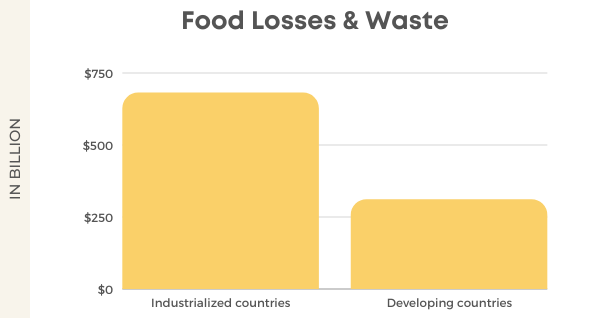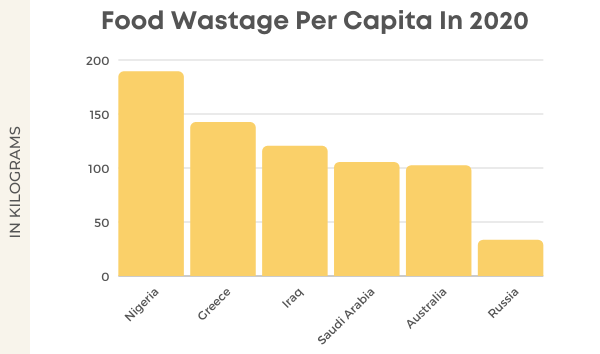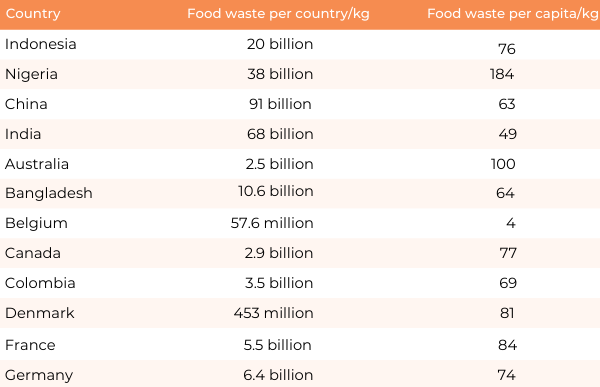As the world is fighting hunger, the amount of food waste is keep on growing. A billion tonnes of food is wasted every year and that impacts the economy, food industry, and environment. Did you know that the biggest amount of wasted food was still edible before it ended up in the trash? That’s the best description of this ongoing problem.
How much food wastage the world produces every year? How does that impact the economy and environment? What are the food waste statistics per country?
In today’s article, we’ll talk about the general food waste statistics, we’re going to focus on specific countries and sectors of the industry, as well as on all the consequences of food waste.
Just keep on reading and you’ll find everything you need to know about this global problem.
Here are the topics we’re going to talk about:
- General Food Waste Statistics
- Food Waste Statistics By Country
- Household Food Waste Statistics
- Supermarket Food Waste Statistics
- Restaurant & Foodservice Food Waste Statistics
- Food Waste In Hotels Statistics
- Consequences Of Food Waste Statistics
12 Key Food Waste Statistics & Data (Editor’s Pick)
- The global volume of food wastage is estimated at 1.6 billion tonnes.
- 1,000 tons of food are wasted every minute.
- 35% of all fish and seafood spend up wasted.
- Out of 263 million tonnes of meat, over 20% of it gets wasted.
- $1.2 billion worth of school lunches in the US is wasted.
- China has enough food waste to feed up to 50 million people.
- India loses 23 million tonnes of food cereals every year.
- In South Africa, food wastage costs about $1.5 billion.
- Households in Indonesia waste 76 kilograms of food per person.
- Supermarkets are responsible for 10% of all US food waste.
- Restaurants lose $162 billion due to wasted food every year.
- Food waste results in 3 billion tons of greenhouses gases.
General Food Waste Statistics
1. Globally, 1.6 billion tonnes of food is wasted every year.
According to the data provided by the Food and Agriculture Organization, the global volume of food wastage is estimated at 1.6 billion tonnes of primary product equivalents. The data also stated that the total food wastage for the edible part of this amount is 1.3 billion tonnes. That is one-third of the food produced in the world for human consumption. And that high figure in tonnes is wasted every single year.


Source: Food and Agriculture Organization
2. Wasted food accounts for $1 trillion.
The mentioned amount of food waste presents approximately $1 trillion worth of food that is lost or wasted every year. Food loss presents food that is damaged as it moves through the supply chain. Food waste is edible food that is thrown away by consumers or retailers. That is a high amount of money spent on the production of food which later on ends up in the garbage.
Source: Food and Agriculture Organization
3. By avoiding waste, there would be enough food for 2 billion people.
According to the Food and Agriculture Organization, also known as the FAO, by reversing the trend of food wasting, there would be preserved enough food to feed 2 billion people. According to hunger statistics, the amount of that preserved food would be more than twice the number of undernourished people across the globe.
Source: Food and Agriculture Organization
4. Every minute, 1,000 tonnes of food is wasted.
To set up a more clear picture of how much food ends up wasted, here is the most shocking number. Roughly, 1,000 tons of food are wasted every minute. And that is terrifying and scary! Millions of people are fighting hunger while the world throws tons of food every 60 seconds.
Source: CompareCamp
5. Food losses and waste account for $310 billion in developing countries.
Both industrialized countries and those that are still developing are fighting food waste. According to the data provided by United Nations, food losses and waste account for roughly $680 billion in industrialized countries. In developing countries, this amount is $310 billion. These are rather high amounts of money that are basically thrown into the garbage while they could actually change the world and save lives.


Source: United Nations
6. In industrialized and developing countries are roughly the same quantities of wasted food.
The mentioned amounts of money present tonnes and tonnes of wasted food. In both industrialized and developing countries, we’re talking about roughly the same quantities of wasted food – 670 and 630 million tonnes of food that end up in the garbage every single year.
Source: United Nations
7. High percentages of wasted fruit, vegetables, roots, and fish.
Let’s talk about specific percentages of food that end up as waste. According to Food and Agriculture Organization, 45% of all fruit, vegetables, roots, and tubers end up as waste. In North America and Oceania alone, 5,814,000 tonnes of roots and tubers are wasted. 35% of all fish and seafood spend up wasted. 8% of that caught fish is thrown back into the sea and most of them are badly damaged, dying, or dead.
Source: Food and Agriculture Organization
8. Over 20% of produced meat is wasted or lost every year.
Additionally, 30% of all cereals end up wasted. According to FAO, in industrialized countries, consumers throw away 286 million tonnes of cereal products. When we’re talking about dairy products, 20% of them are wasted. In Europe alone, 29 million tonnes of dairy products are wasted or lost every year. Out of 263 million tonnes of produced meat, over 20% of it is lost or wasted, while 22% of the global production of oilseeds and pulses is lost or wasted every year.
Source: Food and Agriculture Organization
9. Consumers in rich countries are likely to waste more food.
According to data by the United Nations, consumers in rich countries waste almost as much food as the entire net food production of Sub-Saharan Africa. Rich countries waste about 222 million tonnes of food, while in Africa, that figure goes up to 230 million. The data by Eater stated that consumers start throwing out food when they’re spending up to $6.70 per day. That indicates that people in richer countries are likely to waste more food.
Source: United Nations and Eater
10. About 17% of food ends up in waste.
The United Nations data show that about 17% of total food production is wasted. That high percentage presents 931 million metric tons. That is 1.03 billion tons of food that end up in waste. According to the data, the most waste, 61% of it, happens in households. Foodservice accounts for 26% of the food waste every year, while retailers account for 13%.
Source: United Nations
11. Most food is lost and wasted between harvest and retail.
The data by the State of Food and Agriculture from 2019 stated that globally, 14% of the world’s food is lost after harvesting and before reaching the retail level. That includes on-farm activities, storage, and transportation.
Source: State of Food and Agriculture
12. In industrialized countries, more than 40% of food gets wasted on retail and consumer levels.
The main periods for food loss and waste are once the food comes to the processing levels or when it reaches retail and consumers. The United Nations data shows that 40% of food losses in developing countries occur at post-harvest and processing levels. On the other hand, more than 40% of food in industrialized countries ends up wasted once the food comes at retail and consumer levels.
Source: United Nations
13. One-fourth of the wasted food is enough to feed 870 million people.
More than 950 million people don’t have enough food to eat. The United Nations data states that if only one-fourth of the food that is lost or wasted could be saved, that would feed 870 million hungry people in the world. However, in order to save food, some serious action is needed but for now, there is a minimal number of countries that are working to solve this global problem.
Source: United Nations
14. Almost 30% of the agricultural areas produce food that ends up wasted.
There are numerous areas and fields that are in use for food production. According to the Food and Agriculture Organization, 1.4 billion hectares of land or 28% of the world’s agricultural area is used to produce food that is, in the end, lost or wasted. To think that tonnes of food produced on those fields could feed millions and millions of people.


Source: Food and Agriculture Organization
15. Millions of tonnes of wasted food come from shops, supermarkets, and households.
CompareCamp reported about food waste. According to their data, shops, supermarkets, and households comprise 35% of food waste. A lot of that thrown food at the consumption level is still fit for eating. According to ComfyLiving, supermarkets and restaurants alone provide at least 400 million pounds of food, while 150,000 tons of such food are thrown away each day in the United States.
Source: CompareCamp and ComfyLiving
16. Schools waste food too.
We already mentioned the most usual sectors of the economy which waste the highest amounts of food. However, food is wasted in schools too. According to data provided by ComfyLiving, every year, $1.2 billion worth of school lunches in the United States is wasted. With so many children that don’t have the access to food, this is a terrifying number.
Source: ComfyLiving
17. Food wastage emissions contribute to global warming.
The data by the Food and Agriculture Organization state that food wastage’s carbon footprint is projected at 3.3 billion tonnes of CO2 equivalent to GHG released into the atmosphere every single year. With that in mind, the contribution of wasted food emissions to global warming is almost equivalent (87%) to global road transport emissions.
Source: Food and Agriculture Organization
Food Waste Statistics By Country
18. In the US, every person produces 219 pounds of wasted food.
According to the report by RTS, the United States discards more food than any other country in the world. The report states that nearly 40 million tons of food, or 80 billion pounds, is wasted. Every year. That is estimated to be 30% to 40% of the entire US food supply. These are shocking amounts of wasted food! That means that every person makes 219 pounds of wasted food annually.


Source: RTS
19. Wasted food is the largest component that takes up space in US landfills.
To put everything into the perspective, the mentioned amount of wasted food, 219 pounds per person, is the same as every person who lives in America is throwing more than 650 apples right into the garbage. Or most likely, into landfills where most discarded food ends. In the United States, food is the single largest component taking up space on the landfills there. That makes up 22% of municipal solid waste.
Source: RTS
20. Americans throw away food that is equivalent to a third of their daily calories.
According to data provided by ComfyLiving, around 150,000 tons of food are thrown away every day in the United States. That is on the household level. The mentioned number is equivalent to about a third of the daily calories that every American consumes. According to The Guardian, the healthiest Americans are the most wasteful because of their high consumption of vegetables and fruit, which are frequently thrown out into the garbage.
Source: ComfyLiving and The Guardian
21. Misunderstanding the expiration label is the reason why 80% of Americans throw out perfectly good food.
The report by RTS states that more than 80% of Americans discard perfectly good, consumable food because they misunderstand expiration labels. They truly can be a bit misguiding, however, there is no question that both the date of packing and the expiration date are clearly marked. Sometimes people just have to read in order to understand before they get rid of a bunch of food that is still good and healthy for consumption.
Source: RTS
22. UK households throw away 32% of purchased food.
Households in the United Kingdom are wasting tonnes of food too. According to the data by United Nations, every year, UK households waste around 6.7 million of food. That is one-third of the 21.7 million tonnes of purchased food. This data shows that 32% of all purchased food per year is not eaten.
Source: United Nations
23. About 61% of wasted food could have been eaten.
The United Nations also stated that most of the food waste in the UK, 5.9 million tonnes is currently collected by local authorities. That number presents 88%. The biggest problem is that most of these amounts of food wastage are avoidable. 4.1 million tonnes or 61% of food could have been eaten and not thrown away if it had been better managed.


Source: United Nations
24. Almost 2 million tonnes of food is thrown away in the UK due to fussy eating and personal preferences.
According to the data by WRAP, 1.8 million tonnes of food that is thrown away in the United Kingdom is due to reasons such as accidents, fussy eating, personal preferences, and more. And this puts a highlight to the previous paragraph where we mentioned that millions of tonnes of food waste wouldn’t end up in the garbage if only they were properly managed and bought.
Source: WRAP
25. UK households throw out 8 meals a week.
To make a better picture of the mentioned numbers of food wastage in the United Kingdom, it is enough to say that on average, a UK household will waste the equivalent of eight meals a week. That would be one warm and delicious meal per day, plus an extra one, stuffed straight into the garbage bin. That is terrifying to think of, especially due to the fact that millions of people are starving to death.
Source: WRAP
26. More than 4 million tons of wasted food is perfectly edible.
According to data provided by ComfyLiving, approximately 4.4 million tons of the food that are thrown away in the United Kingdom is perfectly edible. However, they somehow end up in the trash. From this perspective, people should be taught how to manage and treat food because if this trend continues, these numbers will truly be terrifying in the upcoming years, especially with the high growth rate of global hunger.
Source: ComfyLiving
27. China has enough food waste to feed up to 50 million people.
The data provided by International Fund for Agricultural Development, also known as IFAD, stated that more than 35 million tonnes of food are wasted or lost in China every year. That is 6% of China’s total food production. This amount of food waste is enough to feed 30 to 50 million people.
Source: International Fund for Agricultural Development
28. Food wastage in China mostly occurs in the last stage of the supply chain.
Half of the mentioned 35 million tonnes of wasted food in China, about 17 to 18 million tonnes, is wasted at the last stage of the supply chain – at retail or consumption. These numbers repeat themselves every single year. According to the International Fund for Agricultural Development, China can significantly contribute to the global battles against poverty and hunger, by cutting food loss and waste. And in 2021, China officially adopted a law against food waste.


Source: International Fund for Agricultural Development
29. China wastes 50 million tonnes of grain every year.
The United Nations data and statistics show that China wastes about 50 million tonnes of grain every year. That number accounts for one-tenth of the country’s total grain output. While this high amount of wasted grain would help millions of people, tonnes of grain just end in the trash. Every single year.
Source: United Nations
30. India wastes more than 56 million tonnes of food.
India is fighting food wastage too. According to the Food Corporation of India, the country losses 23 million tonnes of food cereals, 21 million tonnes of vegetables, and 12 million tonnes of fruits every year. The food wastage is estimated to be valued at 240 billion Rupees. That would be more than $3.25 billion.
Source: Food Corporation of India
31. Indian agricultural produce that ends up in waste is worth 580 billion Rupees.
The report by the Ministry of Food Processing in India estimated that the country’s agricultural produce worth 580 billion Rupees is wasted every year. On the other hand, one-quarter of the world’s undernourished people live in India.
Source: Ministry of Food Processing and World Food Programme
32. In 2020, Singapore had 11% less food wastage than in the previous year.
According to NEA, the National Environment Agency, food waste accounts for about 11% of the total waste generated in Singapore. In 2019, the overall amount of the generated food waste was 744,000 tonnes, while in 2020, there were 665,000 tonnes, which was 11% less than in the previous year.


Source: National Environment Agency
33. Canadians waste up to 2.2 million tonnes of food.
With a focus on Canada now, it is important to highlight that this country has high amounts of food waste every year. According to the data provided by the National Zero Waste Council, Canadian households waste almost 2.2 million tonnes of edible food every year. That amount is estimated to cost $17 billion.
Source: National Zero Waste Council
34. Almost 60% of food produced in Canada is wasted or lost.
Back in 2019, the data provided by RCI, Radio Canada International, stated that 58% of all food produced in Canada, and we’re talking about 35.5 million tonnes, is lost or wasted. The data showed that a third of that wasted food could be rescued and eaten. It could also be sent to communities in need across the entire country. That would help fight food insecurity and hunger.
Source: Radio Canada International
35. Canadians waste almost 80 kilograms of food per capita.
According to the data provided by Reviewlution, a total of 4.82 million tonnes of food in Canada is lost in the manufacturing process. Canadians waste 79 kilograms of household food per capita, per year. On a yearly basis, that is a total of 2.94 million metric tonnes of wasted food per household.
Source: Reviewlution and Cube Toronto
36. Every Canadian generates 2.7 kilograms of garbage each day.
Canada as the country produces enough food for all its residents, however, with such high numbers of food losses and wastage, 1.4 million Canadian kids don’t have access to healthy food. According to Reviewlution, each Canadian generates around 2.7 kilograms of garbage every day. And out of those kilograms, food is definitely amongst the highest amounts.
Source: Reviewlution
37. Canadian food waste impacts the climate too.
The Reviewlution data states that Canadian food wastage causes 56.6 million tonnes of CO2-equivalent emissions. Besides, food in landfills additionally makes methane gas. That is multiple times more harmful to the climate than carbon dioxide.
Source: Reviewlution
38. Europe has almost 90 million tonnes of wasted food.
When we’re talking about wasted food, Europe is no exception. According to the report by Reuters, 88 million tonnes of food in Europe is wasted on a yearly basis. Such amount of food wastage is estimated to be worth 143 billion euros. That is $177.12 billion.


Source: Reuters
39. Up to 20% of produced food in Europe is wasted.
Eurostat reported that 20% of the total produced food in Europe is lost or wasted. And 33 million European people can’t afford a quality meal every second day. These are defeating numbers and such an amount of wasted food could easily feed the people in Europe. That action would minimize the problems with hunger there too.
Source: Eurostat
40. Wasted food could feed millions of people.
According to the data by the Food and Agriculture Organization of the United Nations from 2013, that year had such an amount of wasted food in Europe, that if it was saved, it could have fed 200 million people. People are not aware of how small actions, such as thoughtful food purchases, can minimalize food waste.
Source: Food and Agriculture Organization
41. In Germany, each person produces 75 kilograms of food waste per year.
When we’re talking about specific European countries and their levels of food wastage, Germany produces the most household food waste in Europe. The data by Statista stated that on average, every person in Germany produces 75 kilograms of food waste every year. On yearly basis, around 12 million tonnes of food waste are generated in the country. Besides, 2 million tonnes of agricultural produce in Germany are wasted too.
Source: Statista and Federal Ministry of Food and Agriculture
42. Finnish households waste up to 160 million kilograms of food per year.
Finland has problems with unnecessarily produced food which burdens both the economy and the environment of the country. According to Luke, the Natural Resources Institute Finland, households there waste 120 to 160 million kilograms of food. That would be 20 to 25 kilograms per person, every year. The institute stated that the total amount of food wasted across the food chain is almost four times these numbers.
Source: Natural Resources Institute Finland
43. In Greece, young people waste the largest amounts of food.
In Greece, 37% of citizens waste food at least 1-2 times a month. According to the Greek Reporter, young people aged 18 to 34 years are wasting even larger amounts of food. The Greek food waste mostly includes fruit, vegetables, dairy products, bread, pasta, leftovers, and more. Speaking of leftovers, 17% of Greeks do not eat them but throw them immediately away.


Source: Greek Reporter
44. In South Africa, there are 1.4 million tons of wasted food.
South Africa is fighting food waste too. There, around 1.4 million tons of food are wasted each year. That amount presents about 15% of the total waste created by households in the country. In South Africa, food wastage costs around R21.7 billion per year. That is about $1.5 billion. This is a high and significant amount of wasted food, but it still isn’t as bad as the amount of wastage in the United States.
Source: ComfyLiving
45. Europe and North America are wasting 10 times more food than parts of Africa and Asia.
According to the data provided by United Nations, in Europe and North America, per capita waste by consumers is between 95 to 115 kilograms a year. In Sub-Saharan Africa, South, and Southeastern Asia, each consumer throws away only 6 to 11 kilograms per year.
Source: United Nations
46. Around 7.6 million tonnes of food is wasted in Australia every year.
Food waste is a big problem in Australia. Every year, Australians waste around 7.6 million tonnes of food across the supply and consumption chain. This amount of wastage equals about 312 kilograms per person. That would be around one in five bags of groceries worth $2,000 to $2,500 per household per year.
Source: Department of Agriculture, Water and the Environment
47. Food waste massively impacts the Australian economy.
The data provided by FIAL, The Food and Agribusiness Growth Centre, stated that food waste costs the Australian economy $36.6 billion a year. The top five most wasted foods in the country are bread, fruit, vegetables, bagged salad, and leftovers. While over 5 million people experience food insecurity each year in Australia (one-quarter of them are children), Australian households produce 2.5 million tonnes of food waste.
Source: The Food and Agribusiness Growth Centre
48. Turkey throws almost 20 million tonnes of food per year.
One of the countries with the biggest problem regarding food waste is Turkey. The country throws out 18 million tonnes of food every year. When the food is discarded this way, the valuable resources used in its production are also lost. That’s even before the high costs of food disposal are taken into account.
Source: United Nations
49. Spanish households waste 18% of their food.
Spain has problems with food waste too. According to the data provided by EU Fusions, Spanish households waste 18% of their food. That percentage is equivalent to 2.9 million tonnes of food per year. In the financial segment, this amount of food waste is valued at 11 billion Euros.
Source: EU Fusions
50. Japan produces almost 30 million tons of food waste.
Japan produces around 27.59 million tons of food waste every year, according to data provided by the Ministry of Agriculture, Forestry and Fisheries, and the Ministry of the Environment. Out of that high amount of food wastage, 6.43 million tons of thrown-away food is still edible. That number is equivalent to around 51 kilograms of waste per person each year.
Source: Ministry of Agriculture, Forestry and Fisheries, and the Ministry of the Environment
51. In 2020, Russia made 33 kilograms of food wastage per capita.
According to Statista, Nigeria produced 189 kilograms of food waste per capita in 2020. In second place was Greece with 142 kilograms, followed by Iraq with 120 kilograms of food waste per capita. Saudi Arabia is in fourth place with 105 kilograms, while Australia had 102 kilograms. Other countries which were mentioned in the report have less than 100 kilograms of food wastage per capita. In the report, Russia was ranked last with 33 kilograms of food wastage per capita.


Source: Statista
Household Food Waste Statistics
52. Almost 570 million tonnes of food waste is made by households.
According to data provided by Forbes, most of the food waste, or to be more precise, 569 million tonnes of it, falls under the category of the household. Most people buy food without thinking about the expiration date, the amount of food they actually need, and more. Those and similar reasons are the most common ones when speaking of the food waste by households.
Source: Forbes
53. Out of the total amount of food waste, 61% is coming from households.
The data by World Economic Forum stated that 17% of global food production may go wasted, however, 61% of that waste is coming from households. The household food waste per capita is similar accord high-income, upper-middle-income, and lower-middle-income countries. The World Economic Forum stated that the data for low-income countries were insufficient.
Source: World Economic Forum
54. Per capita, 74 kilograms of food is wasted worldwide.
The average global household waste per capita is 74 kilograms of food every year. That is a lot of food waste on a global basis that can feed millions and millions of people who are fighting food insecurity, hunger, starvation, and malnutrition.
Source: Forbes
55. Households in the United States, France, and Germany waste millions of food per year.
United States, France, and Germany are often called out because of the amount of food that each country losses and wastes. According to Forbes, US households throw away about 19.4 million tonnes of food every year, while households in France and Germany waste about 5 to 6 million tonnes of food on a yearly basis.
Source: Forbes
56. The UK household food waste makes up 70% of the total food waste.
When we’re talking about the state of household food waste in the United Kingdom, by weight, such waste makes up to 70% of the total food waste in the country. That is a high percentage of food thrown out, especially due to the fact that most of the food was still edible and safe. With that being said, UK households are responsible for 6.6 million tonnes of food waste every year.
Source: WRAP
57. UK households waste 570,000 tonnes of fresh meat.
According to The Guardian and their report from 2014, UK households waste around 570,000 tonnes of fresh meat. That number includes 50 million chickens, 1.5 million pigs, and 100,000 beef cattle. The amount of meat waste made by the households is valued at £1,300 million. The Guardian stated that half of that meat waste could still be eaten.
Source: The Guardian
58. Austrian households waste almost 350 million kilograms of food.
The statistics from the United Nations Environment Programme’s 2021 Food Waste Index report were used in order to make the estimated household waste statistics. According to that report, Austrian households annually waste 349 million kilograms of food. Per person, that is 38 kilograms.
Source: 24/7 Wall
59. Zambia waste more than 1.4 billion kilograms of food every year.
The already mentioned report stated that households in Indonesia waste more than 20 billion kilograms of food. That is 76 kilograms of wasted food per person. Nigeria, China, and India also have high levels of household wasted food. According to the report, households in Nigeria waste almost 38 billion kilograms of food, in China 91 billion kilograms of food, and in India more than 68 billion kilograms.


Source: 24/7 Wall
60. Households in Belize waste about 20.5 million kilograms of food.
According to that report from the previous paragraphs, some of the countries with the lowest amount of food waste are Belgium, Belize, Ireland, and Luxembourg. To be more specific, households in Belgium waste 57 million kilograms of food per year, in Belize 20.5 million kilograms, in Ireland 26.7 million kilograms, and in Luxembourg, households waste around 55 million kilograms of food.
Source: 24/7 Wall
Supermarket Food Waste Statistics
61. About 30% of food in the US retail stores is wasted every year.
The data provided by RTS states that 30% of food in American grocery stores is thrown away. That high percentage presents more than 7.2 billion kilograms of food wasted by the US retail stores. The data presents the amount of food that is wasted every year.
Source: RTS
62. The US food supply chain wastes 45% of all products.
Speaking of the United States, supermarkets are responsible for 10% of all US food waste. According to The Guardian, the food supply chain wastes 45% of all produce, 20% of meat and dairy products, 30% of cereals, and 25% of seafood. The food containers and packaging make 23% of landfill waste, stated the Environmental Protection Agency.
Source: The Guardian and Environmental Protection Agency
63. More than 19.5 billion kilograms of food are never sold.
According to Quest Resource Management Group, 10% of food in grocery stores will never make it off the shelf. That percentage presents a high number of more than 19.5 billion kilograms of food that end up wasted. About 12% of fruit and 11.5% of vegetables are never sold either.
Source: Quest Resource Management Group
64. In the UK’s retail, 100,000 tonnes of food go wasted.
The data from the United Kingdom is no different. Every year, 100,000 tonnes of readily available and edible food from the UK’s retail, as well as the food manufacturing sector, is wasted. That number is equivalent to 250 million uneaten meals. Instead of human consumption, such food ends up in the animal feed, it is used for anaerobic digestion or goes to landfill. However, placing wasted food in landfills brings devastating environmental consequences.
Source: The Grocer
65. Supermarkets in Egypt are wasting food due to insufficient storage facilities.
According to data by Modern Restaurant Management, Egypt is having problems with supermarkets’ food wastage too. The data states that supermarkets in Egypt are wasting 20% of produce due to insufficient storage facilities. Lack of storage and refrigerators definitely contribute to the increased food wastage in some countries.


Source: Modern Restaurant Management
Restaurant & Foodservice Food Waste Statistics
66. Restaurant and food service account for 93% of food waste in the hospitality sector.
According to data by Thistle Thoughts, restaurants and food service accounts for 17.1 million tons of food waste. Restaurants and food service businesses account for 93% of the food waste generated in the hospitality sector. The hospitality sector in total generates approximately 18.3 million tons of food waste every year.
Source: Thistle Thoughts
67. Approximately 85% of food is thrown out.
Move For Hunger reported that half a pound of food is wasted per meal in restaurants. This includes the leftovers on a customer’s plate, as well as the food in the kitchen itself. The report also stated that 85% of the food that isn’t used in a typical American restaurant is thrown out while only a small percentage of such food is donated or recycled.
Source: Move For Hunger
68. Food waste is expensive.
Eventually, all the massive amounts of food waste cost a lot of money. According to USDA, the U.S. Department of Agriculture, the restaurant industry losses $162 billion every year due to wasted food. The most usual factors which contribute to the defeating results of wasted food are lack of awareness, overproduction, unsuccessful employee training, improper food storage, as well as lack of access to composting facilities.
Source: Food Print
69. Up to 40% of served food never gets consumed.
The FoodPrint data stated that the foodservice industry has huge potential for savings. In the United States, there are more than one million restaurant locations that employ 10% of the entire US workforce. Such industry accounts for 4% of the country’s gross domestic product. However, the study found that from 4% to 10% of food purchased by restaurants actually never gets to the customers. 30% to 40% of the food that is served to customers never gets consumed.
Source: FoodPrint
70. More than 70% of US diners care about restaurants’ food waste.
Consumers and diners worry about food waste too. According to the study conducted by Unilever, 72% of the US diners care about the way restaurants handle food waste. What’s interesting is the fact that 47% of them are willing to spend more money at restaurants that have an active food recovery program.
Source: Unilever
71. Restaurants produce more than 900,000 tonnes of waste.
The data by Modern Restaurant Management showed that restaurants produce 915,400 tonnes of waste every year. Out of that high amount, 199,100 tonnes is food wastage. According to the available data, that amount accounts for 22% of the total food waste from the restaurant sector.


Source: Modern Restaurant Management
72. A quarter of food waste goes to organizations fighting hunger.
In the United States, 21% of wasted food, or nearly a quarter of it, is donated to help does in need through organizations such as Feeding America. The food is mainly rescued from restaurants and supermarkets and then collected in food banks. 14% of food waste is sent for animal feed, while another 14% is used for energy and fertilizer.
Source: Thistle Thoughts
Food Waste In Hotels Statistics
73. Hotels produce almost 300,000 tonnes of waste every year.
Modern Restaurant Management stated that hotels produce 289,700 tonnes of waste every year. Out of that number, 79,000 tonnes of the waste is food. That would be 9% of the total food waste from the hotel sector. The hospitality sector is fighting great losses of food every year.
Source: Modern Restaurant Management
74. Hotel kitchens waste 15% of the value of the purchased food.
According to the data provided by ALICE, hotel kitchens traditionally budget 3% to 5% of food purchasing costs to be written of as food waste. However, kitchens actually waste somewhere between 5% and 15% of the value of the food they have purchased. And that is a lot of wasted money and food. Especially if we’re talking about smaller hotels that can’t afford such losses.
Source: ALICE
75. Food waste from the hospitality sector is expensive and bad.
Food waste is not only bad for the environment but it also has a negative impact on the economy too. Hospitality sector losses more than $100 billion every year on wasted food. Due to such losses, some hotels will need to be closed because this is too much of a negative impact on their business.


Source: ALICE
Consequences Of Food Waste Statistics
76. As the world throws out more than a third of all food, 9 million people starve to death every year.
According to the restaurant, home, and grocery store food waste statistics, the amount of thrown-away food would be enough to feed the world’s hungry people four times over. The data provided by NPR states that 9 million people starve to death every year, while more than a third of all the food ends up in the trash. These days, more people die of hunger, than they do from AIDS, malaria, and tuberculosis all combined together.
Source: NPR
77. Food waste results in large amounts of methane gas.
Data from Move For Hunger states that the food waste that ends up in landfills results in high levels of methane gas. This gas is a stronger greenhouse gas than CO2. Methane is extremely bad for the earth’s atmosphere and it contributes to global warming, as well as to climate change.
Source: Move For Hunger
78. Food waste results in 3 billion tons of greenhouse gases.
Speaking of global warming, once wasted food comes to the landfill, it rots and then emits greenhouse gases. Every year, 3 billion tons of greenhouse gases are emitted due to food waste. To explain it more specifically, if wasted food were a country, it would be the third-largest producer of carbon dioxide, right after the United States and China.
Source: World Food Programme
79. Wasting food means wasting water too.
Food waste also impacts the water. Food waste is responsible for the usage of such an amount of water that could fill Lake Geneva three times! According to the data provided by Move For Hunger, one wasted kilogram of beef equals 50,000 liters of water that was used for no reason.
Source: Move For Hunger
80. Around 30% of agricultural land is filled with wasted food.
The world has a lot of possible agricultural land which can be used for producing food. However, wasted food takes up 1.4 billion hectares of agricultural area. That means that around 30% of agricultural land is globally taken up by produced and uneaten food. Due to that, this large area can’t be used for agricultural purposes. This area is so large as if we would combine the size of the US, India, and Egypt altogether.


Source: TriplePundit and The World Counts
81. Wasted food is estimated to have a value close to $1 trillion.
Besides all the bad environmental impacts of food waste, such wastage impacts the economy too. On a yearly basis, the direct economic consequences of food waste are valued at $750 billion. That number doesn’t include the value of fish and seafood. According to the United Nations and The World Counts, if we count fish and seafood into that mentioned number, we will be close to $1 trillion.
Source: United Nations and The World Counts
To Wrap It Up
Food waste is a huge problem in today’s world. With millions of people fighting hunger, the world is throwing away one-third of all the food produced for human consumption. And that statistic repeats itself every year. Food waste also impacts the economy and environment in which it emits 3 billion tons of greenhouse gases. There are many possible ways of finding a good solution to this problem, however, we need to raise more awareness and start with small steps. Every household can make great changes and eventually contribute to the reduction of food wastage in the world.

















Leave a Reply